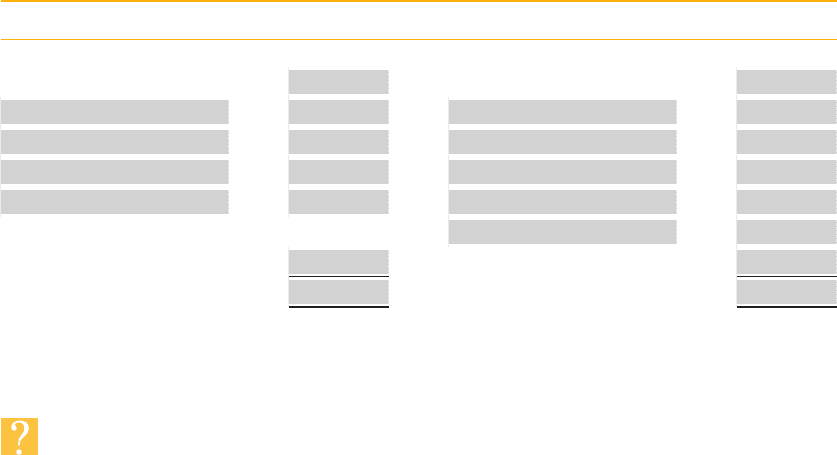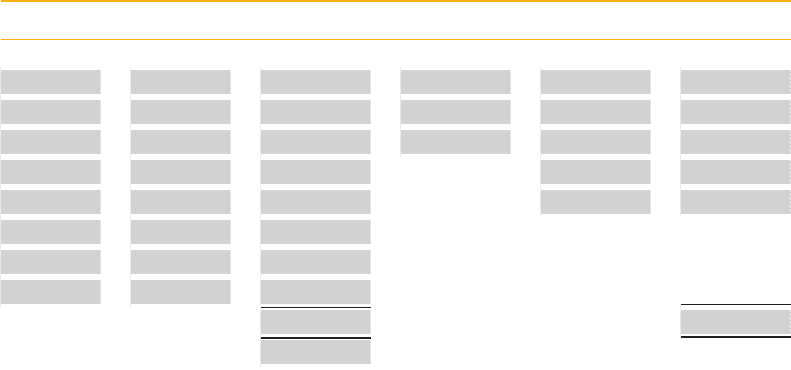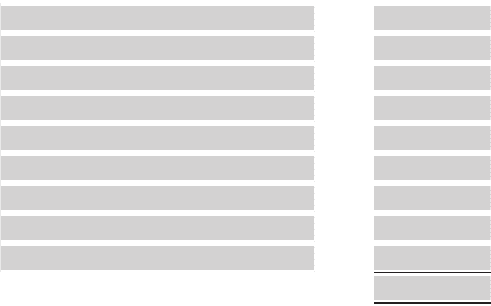CIMA CO2 Official Learning System - Fundamentals of Financial Accounting
Подождите немного. Документ загружается.

PREPARING FOR THE COMPUTER-BASED ASSESSMENTS (CBAs)
REVISION QUESTIONS C2
630
The following additional information at 31 October 20X1 is available:
(i) Closing inventories of goods for resale are valued at $106 m.
(ii) Distribution expenses include $1 m carriage inwards and $3 m carriage outwards.
(iii) Prepayments
$ m
Telephone rental 1
Insurance 2
(iv) Accruals
$ m
Wages and salaries 3
Telephone call charges 4
Directors ’ fees 2
Auditors ’ fees 1
(v) The fi gure in the trial balance for the bank balance is the balance appearing in the
cash book prior to preparing a bank reconciliation. On receipt of the bank state-
ment, it is discovered that
●
unpresented cheques amount to $3 m;
●
bank charges not recorded in the cash book amount to $2 m;
●
a cheque for $1 m from a customer has been dishonoured and not recorded in the
ledgers.
(vi) Bad debts to be written off amount to $5 m (including the dishonoured cheque
referred to in note (v) above), and the allowance for receivables is to be amended to
2.5 per cent of receivables.
(vii) Depreciation on non-current assets is to be provided as follows:
●
plant and machinery, 10 per cent on cost;
●
o f fi ce equipment, 33 1/3 per cent on the reducing balance.
(viii) An accrual of $2 m is to be made for income tax.
(ix) $20m is to be transferred to general reserves.

PREPARING FOR THE COMPUTER-BASED ASSESSMENTS (CBAs)
631
FUNDAMENTALS OF FINANCIAL ACCOUNTING
Requirements
(a) Insert the missing items in the income statement for the year ended 31 October
20X1
Income statement of EMP plc for the year ended 31 October 20X1
$m $m $m
Sales
Cost of sales
Gross profi t
Operating profi t
(9 marks)

PREPARING FOR THE COMPUTER-BASED ASSESSMENTS (CBAs)
REVISION QUESTIONS C2
632
(b) Insert the missing items in the statement of changes in equity for the year ended 31
October 20X1
Statement of changes in equity of EMP plc for the year ended 31 October 20X1
General reserves Retained earnings Total
$m $m $m
Balance at the start of the period
Balance at the end of the period
(3 marks)
(c) Insert the missing items in the statement of fi nancial position at 31 October 20X1.
Statement of fi nancial position of EMP plc at 31 October 20X1
Cost Acc. Depreciation Carrying
Amount
Assets $m $m $m $m
Non-current assets
Current assets
Equity and liabilities
Current liabilities
(8 marks)

PREPARING FOR THE COMPUTER-BASED ASSESSMENTS (CBAs)
633
FUNDAMENTALS OF FINANCIAL ACCOUNTING
(d) State the formulae for and calculate the following ratios by inserting the missing
items.
(i) Acid test or quick ratio
Formula :
Figures : :
(ii) Inventories days
Formula
Figure
days
(4 marks)
(Total marks 24)
Question 32
Your organisation’s year end is 31 October. Prior to producing the trial balance at 31
October 20X0, your supervisor has passed you the following list of errors and omissions
(i) Purchase of raw materials on credit from J Brown had been completely omitted. The
list price was $9,000, less trade discount of 331/3 per cent, with cash discount of 2
per cent offered for payment before 31 October 20X0. The invoice is still outstanding
at the end of the month.
(ii) Offi ce equipment valued at $4,000 was received in part payment of a debt of $4,500
from Zhang. The balance of Zhang’s debt is to be written off. No entries have been
made for either of these transactions. No depreciation is to be charged on the offi ce
equipment.
(iii) Administration expenses paid, of $5,300, had been credited to administration
expenses and debited to the bank account.
(iv) Offi ce equipment had been disposed of during the year. The cost ($4,200) and accu-
mulated depreciation ($3,320) had been correctly transferred to the disposals account,
but no other entries had been made. The disposal proceeds of $720 have not yet been
received.
(v) Staff wages accrued of $3,000 gross had been omitted. Employees ’ income tax was
$450, employees ’ social security tax contributions were $120 and employer’s social
security tax contributions were $130. All payments will be made after 31 October
20X0.

PREPARING FOR THE COMPUTER-BASED ASSESSMENTS (CBAs)
REVISION QUESTIONS C2
634
Requirements
(a) Insert the missing items in the journal entries to correct the above errors and
omissions.
Journal entries
Debit Credit
$ $
(i)
(ii)
(iii)
(iv)
(v)
(7 marks)
(b) If the above errors had not been corrected, the net profi t for the year ended 31
October 20X0 would have been $37,500. Recalculate the net profi t after taking into
account the above corrections, by inserting the missing fi gures in the schedule below.
Recalculated net profi t
$
Net profi t before adjustments 37,500
Amended net profi t
(4 marks)

PREPARING FOR THE COMPUTER-BASED ASSESSMENTS (CBAs)
635
FUNDAMENTALS OF FINANCIAL ACCOUNTING
(c) A replacement engine had been purchased for a machine during the year. The whole
cost of $25,000 had been charged to the ‘ machinery cost account ’ , and depreciation
of 10 per cent on the full amount had been charged. You are now informed that only
$10,000 of the cost was deemed to be in respect of an improvement in the productive
capacity of the machine.
You are required to :
(i) complete the missing words in the following sentences:____ expenditure is the
acquisition, production or enhancement of ____ assets. ____ expenditure includes
the purchase of goods for resale, and expenditure on goods and services to be ____
during the reporting period.
(6 marks)
(ii) calculate the effect that the incorrect treatment of this expenditure will have had
on the profi t for the year, by inserting the missing fi gures in the schedule below.
Effect of incorrect treatment
$
(3 marks)
(Total marks 20)
Question 33
You are given the following information relating to PB’s business for the month of October
20X0:
$
Owing by customers at 1 October 20X0 95,760
Owing to customers at 1 October 20X0 3,400
Owing to customers at 31 October 20X0 5,750
Sales during the month
Cash sales (including sales tax at 17.5%) 9,400
Credit sales (including sales tax at 17.5%) 757,875
Receipts from customers (including cash sales) 739,000
Discounts allowed to credit customers 2,450
Refunds made to credit customers 4,385
Returns inwards (excluding sales tax at 17.5%), all on credit 25,800
Bad debts written off 2,875
Dishonoured cheques from credit customers 15,215
The allowance for receivables is 2 per cent of net balance at 31 October 20X0.
In addition, PB was notifi ed on 30 October 20X0 that she would be receiving a divi-
dend of 20¢ in the pound from a previously written-off bad debt of $6,000. The amount
was received in November 20X0.

PREPARING FOR THE COMPUTER-BASED ASSESSMENTS (CBAs)
REVISION QUESTIONS C2
636
She also has a customer owing $5,400, who is also a supplier of hers. The balance in the
purchase ledger is $8,200, and she agreed to offset the balances.
You are required to prepare a sales ledger control account for PB for the month of
October 20X0, using the information above, by inserting the missing items below.
Sales ledger control account
$ $
Balance b/f Balance b/f
Balance c/f
Balance c/f
(7 marks)
Question 34
Your organisation maintains a single ledger account for rent, local business tax and
insurance.
On 1 November 20X0, the following balances were to be brought forward on the
account:
$
Rent accrued for October 20X0 700
Local business tax prepaid to 31 March 20X1 550
Insurance prepaid to 31 December 20X0 400
During the next year, the following payments were made:
●
Rent . $2,100 per quarter, payable on 1 November, 1 February, 1 May and 1 August. The
May payment was made with the August payment.
●
Local business tax . $1,200, for the year ending 31 March 20X2, paid on 8 April 20X1.
●
Insurance . $3,000, for the year ending 31 December 20X1, paid on 28 December 20X0.
In addition, a refund of insurance for the year ended 31 December 20X0, of $80, was
received on 3 January 20X1.
Requirements
(a) Insert the missing items in the ledger account for rent, local business tax and insur-
ance for the year ended 31 October 20X1, showing clearly the amount to be trans-
ferred to the income statement for the year, and the amounts accrued and/or prepaid
at the end of the year.

PREPARING FOR THE COMPUTER-BASED ASSESSMENTS (CBAs)
637
FUNDAMENTALS OF FINANCIAL ACCOUNTING
Rent, local business tax and insurance
Date Account $ Date Account $
(8 marks)
(b) Insert the missing words in these sentences relating to the conventions of prudence
and accruals.
The ____ convention stipulates that ____ and ____ should not be anticipated.
However, ____, ____ and ____ should be provided for as soon as it is known that an
____ has been incurred that relates to the accounting period, or the possibility of a
____ or ____ exists.
The ____ ( or ____) convention stipulates that ____ and ____ are matched with each
other in accordance with the period to which they relate, regardless of the period in
which the ____ or ____ occurs.
(5 marks)
(c) Your organisation made a net profi t of $47,500 for the year ended 31 October 20X1.
This was after charging depreciation of $8,200 and a loss on disposal of non-current
assets of $1,200. The proceeds of sale of the non-current asset were $5,400.
During the year, the carrying amount of non-current assets rose by $18,000; receiv-
ables increased by $2,500; inventories decreased by $5,200 and payables increased by
$1,800. The proprietor withdrew $7,000 of the profi ts for his own use, and paid off a
long-term loan of $8,000.
Insert the missing items in the schedule for the change in the bank balance as a
result of the above transactions.

PREPARING FOR THE COMPUTER-BASED ASSESSMENTS (CBAs)
REVISION QUESTIONS C2
638
Change in bank balance
$
P r o fi t for the year 47,500
Increase in bank balance
(7 marks)
(Total marks 20)

639
Solutions to
Revision Questions
Solution 1
1.1 Answer: (C)
There are several ways a candidate could identify the correct answer here, including
the process of elimination. Answers (A) and (D) cannot be right as they both include
a debit to the cash account, and as the company is making a payment a credit to the
cash account is required. The difference between answers (B) and (C) is the amount of
cash discount given. This should be calculated as 2 per cent of the net goods value, that
is, the value after deducting the trade discount. The net goods value is $400 less $100
trade discount $300, therefore the cash discount is $6 and answer (C) is correct.
Taking the question in order of action, the initial purchase should be recorded
ignoring the cash discount, as it is not known at the time of purchase whether pay-
ment will be made in time to become entitled to the cash discount. Trade discount
is always deducted at once, and thus the initial entries are Debit purchases, Credit
ABC Ltd with $300. On payment, ABC Ltd is debited with $300, the amount paid
out (and credited to the bank) is $300 – $6 cash discount, and the discount is cred-
ited to Discount received (being an item of revenue).
1.2 Answer: (B)
A spreadsheet is ideal for preparing budgets and forecasts, using a columnar format
with the accounting periods across the top and the items of revenue/expense and
so on, down the columns. It is also ideal for use as a daybook, again with a colum-
nar format with the invoice numbers and, listed vertically and the columns headed
‘ Gross ’ , ‘ sales tax ’ and ‘ Net ’ (perhaps with further analysis columns). An extended
trial balance could also be prepared using a spreadsheet, with the accounts listed ver-
tically and the columns used for the trial balance fi gures, adjustments, income state-
ment items and, fi nally, statement of fi nancial position items. Double-entry records
would require several spreadsheets, one for each account, and recording the dual
aspect would mean locating the two relevant spreadsheets and the appropriate cells,
making this application much more diffi cult.
1.3 Answer: (D)
The suspense account is debited or credited as a result of an imbalance in the trial
balance. A debit balance would arise if the credit side of the trial balance were greater
than the debit side. Option (A) would result in the debit side being greater than the
